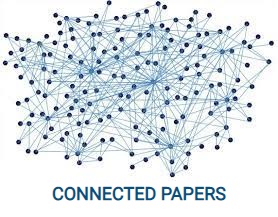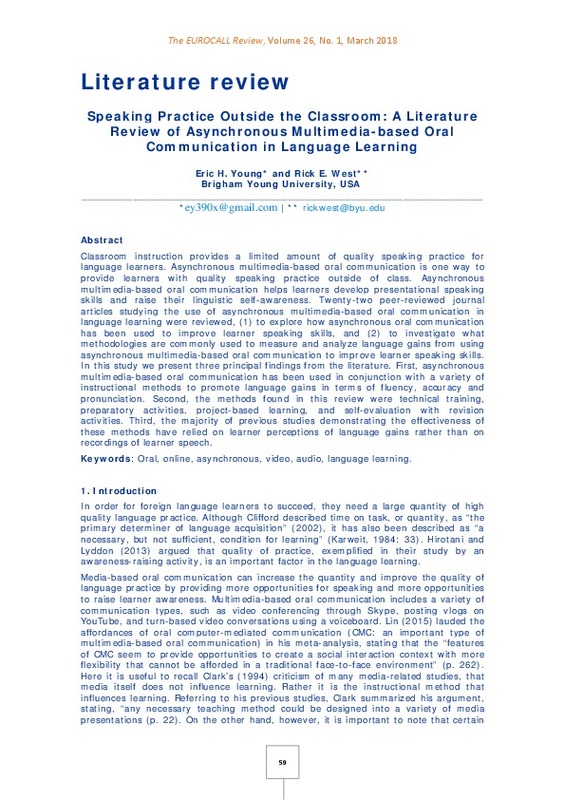American Council on the Teaching of Foreign Languages. (2012). Performance descriptors for language learners. http://www.actfl.org/publications/guidelines-and-manuals/actfl-performance-descriptors-language-learners
Abuseileek, A. F., & Qatawneh, K. (2013). Effects of synchronous and asynchronous computer-mediated communication (CMC) oral conversations on English language learners' discourse functions. Computers and Education, 62, 181-190. doi:10.1016/j.compedu.2012.10.013
Bakar, N. A., Latiff, H., & Hamat, A. (2013). Enhancing ESL learners speaking skills through asynchronous online discussion forum. Asian Social Science, 9(9), 224-234. doi:10.5539/ass.v9n9p224
[+]
American Council on the Teaching of Foreign Languages. (2012). Performance descriptors for language learners. http://www.actfl.org/publications/guidelines-and-manuals/actfl-performance-descriptors-language-learners
Abuseileek, A. F., & Qatawneh, K. (2013). Effects of synchronous and asynchronous computer-mediated communication (CMC) oral conversations on English language learners' discourse functions. Computers and Education, 62, 181-190. doi:10.1016/j.compedu.2012.10.013
Bakar, N. A., Latiff, H., & Hamat, A. (2013). Enhancing ESL learners speaking skills through asynchronous online discussion forum. Asian Social Science, 9(9), 224-234. doi:10.5539/ass.v9n9p224
Baker-Smemoe, W., Dewey, D. P., Bown, J., & Martinsen, R. A. (2014). Does measuring L2 utterance fluency equal measuring overall L2 proficiency? Evidence from five languages. Foreign Language Annals, 47(4), 707-728. doi: 10.1111/flan.12110
Castañeda, M., & Rodríguez-González, E. (2011). L2 speaking self-ability perceptions through multiple video speech drafts. Hispania, 94(3), 483-501.
Clark, R. (1994). Media will never influence learning. Educational Technology Research and Development, 42(2), 21-29. doi: 10.1152/advan.00094.2010
Clifford, R. (2002). Achievement, performance, and proficiency testing. Paper presented at the Berkeley Language Center Colloquium on the Oral Proficiency Interview, University of California at Berkley.
Crookes, G. (1989). Planning and interlanguage variation. Studies in Second Language Acquisition, 11(4), 367-383.
Delaney, T. (2012). Quality and quantity of oral participation and English proficiency gains. Language Teaching Research, 16(4), 467-482. doi: 10.1177/1362168812455586
Dixon, E. M., & Hondo, J. (2014). Re-purposing an OER for the online language course: A case study of Deutsch Interaktiv by the Deutsche Welle. Computer Assisted Language Learning, 27(2), 109-121. doi: 10.1080/09588221.2013.818559
Dona, E., Stover, S., & Broughton, N. (2014). Modern languages and distance education: Thirteen days in the cloud. Turkish Online Journal of Distance Education, 15(3), 155-170.
Engin, M. (2014). Extending the flipped classroom model: Developing second language writing skills through student-created digital videos. Journal of the Scholarship of Teaching and Learning, 14(5), 12-26. doi:10.14434/josotlv14i5.12829
Fukushima, T. (2002). Promotional video production in a foreign language course. Foreign Language Annals, 35(3), 349-355.
Gleason, J. & Suvorov, R. (2012). Learner perceptions of asynchronous oral computer-mediated communication: Proficiency and second language selves. Canadian Journal of Applied Linguistics, 15(1), 100-121.
Goulah, J. (2007). Village voices, global visions: Digital video as a transformative foreign language learning tool. Foreign Language Annals, 40(1), 62-78. doi: 10.1111/j.1944-9720.2007.tb02854.x
Gromik, N. A. (2012). Computers & education cell phone video recording feature as a language learning tool: A case study. Computers & Education, 58(1), 223-230. doi: 10.1016/j.compedu.2011.06.013
Graham, C. (2006). Blended learning systems: Definition, current trends, and future directions. In Bonk, C. & Graham, C. (eds.), Handbook of blended learning: Global perspectives, local designs (pp. 3-21). San Francisco: Pfeiffer. doi: 10.2307/4022859
Hastie, P., Brock, S., Mowling, C. & Eiler, K. (2012). Third grade students' self-assessment of basketball dribbling tasks. Journal of Physical Education and Sport, 12(4), 427-430. doi: 10.7752/jpes.2012.04063
Hirotani, M. (2009). Synchronous versus asynchronous CMC and transfer to Japanese oral performance. Calico Journal, 26(2), 413-438. doi: 10.1016/j.cpen.2012.02.001
Hirotani, M. & Lyddon, P. A. (2013). The development of L2 Japanese self-introductions in an asynchronous computer-mediated language exchange. Foreign Language Annals, 46(3), 469-490. doi: 10.1111/flan.12044
Hung, S. T. (2011). Pedagogical applications of Vlogs: An investigation into ESP learners' perceptions. British Journal of Educational Technology, 42(5), 736-746. doi: 10.1111/j.1467-8535.2010.01086.x
Jamshidi, R., LaMasters, T., Eisenberg, D., Duh, Q. Y. & Curet, M. (2009). Video self-assessment augments development of videoscopic suturing skill. Journal of the American College of Surgeons, 209(5), 622-625. doi: 10.1016/j.jamcollsurg.2009.07.024
Karweit, N. (1984). Time on task reconsidered: Synthesis of research on time and learning. Educational Leadership, 41(8), 32-35.
Kirkgöz, Y. (2011). A blended learning study on implementing video recorded speaking tasks in task-based classroom instruction. Turkish Online Journal of Educational Technology, 10(4), 1-13.
Kitade, K. (2000). L2 learners' discourse and SLA theories in CMC: Collaborative interaction in internet chat. Computer Assisted Language Learning, 13(2), 143-166. doi: 10.1076/0958-8221(200004)13
Kormos, J. & Dénes, M. (2004). Exploring measures and perceptions of fluency in the speech of second language learners. System, 32(2), 145-164. doi: 10.1016/j.system.2004.01.001
Lamy, M.-N. & Goodfellow, R. (1999). "Reflective conversation" in the virtual classroom. Language Learning & Technology, 2(2), 43-61.
Lepore, C. E. (2014). Influencing students' pronunciation and willingness to communicate through interpersonal audio discussions. Dimension, 73-96.
Lin, H. (2015). Computer-mediated communication (CMC) in L2 oral proficiency development: A meta-analysis. ReCALL, 27(3), 261-287. doi: 10.1017/S095834401400041X
McIntosh, S., Braul, B. & Chao, T. (2003). A case study in asynchronous voice conferencing for language instruction. Educational Media International, 40(1), 63-73. doi: 10.1080/0952398032000092125
Ono, Y., Onishi A., Ishihara M. & Yamashiro M. (2015). Voice-based computer mediated communication for individual practice to increase speaking proficiency: Construction and pilot study. In Zaphiris P. & Ioannou A. (eds.), Learning and collaboration technologies. LCT 2015. Lecture Notes in Computer Science, 9192. New York: Springer.
Pop, A., Tomuletiu, E. A. & David, D. (2011). EFL speaking communication with asynchronous voice tools for adult students. Procedia - Social and Behavioral Sciences, 15, 1199-1203. doi: 10.1016/j.sbspro.2011.03.262
Sauro, S. & Smith, B. (2010). Investigating L2 performance in text chat. Applied Linguistics, 31(4), 554-577.
Segalowitz, N. (2010). Cognitive bases of second language fluency. New York: Routledge.
Shih, R. (2010). Blended learning using video-based blogs: Public speaking for English as a second language students. Australasian Journal of Educational Technology, 26(6), 883-897.
Sun, Y. C. (2012). Examining the effectiveness of extensive speaking practice via voice blogs in a foreign language learning context. CALICO Journal, 29(3), 494-506.
Sun, Y.C. & Yang, F.Y. (2015). I help, therefore, I learn: Service learning on Web 2.0 in an EFL speaking class. Computer Assisted Language Learning, 28(3), 202-219. doi: 10.1080/09588221.2013.818555
Tiraboschi, T. & Iovino, D. (2009). Learning a foreign language through the media. Journal of E-Learning and Knowledge Society, 5(3), 133-137.
Tognozzi, E. & Truong, H. (2009). Proficiency and assessment using WIMBA voice technology. Italica, 86(1), 1-23.
Yaneske, E. & Oates, B. (2010). Using voice boards: Pedagogical design, technological implementation, evaluation and reflections. Australasian Journal of Educational Technology, 26(8), 233-250. doi: 10.3402/rlt.v18i3.10767
Ziegler, N. (2013). Synchronous computer-mediated communication and interaction: A research synthesis and meta-analysis (Doctoral dissertation). Washington, DC.
[-]







![HTML file [HTML]](/themes/UPV/images/html.png)

